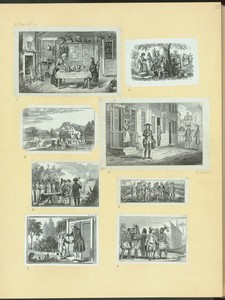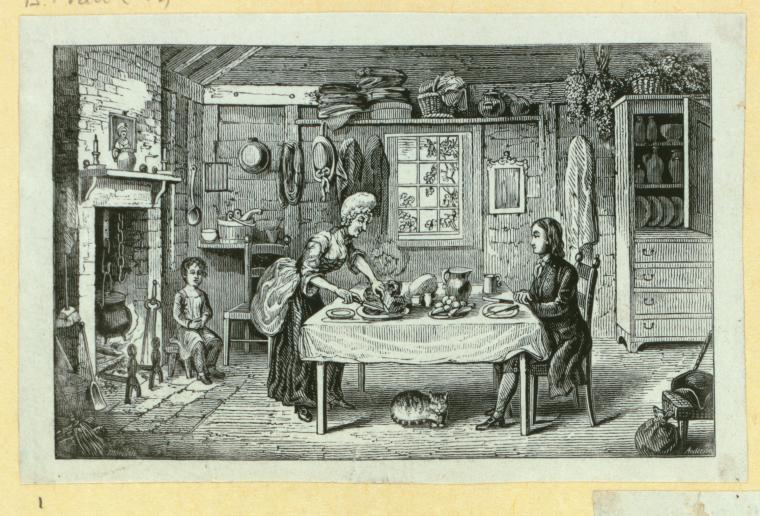The pieces shown are engraved by Alexander Anderson. Anderson was an American physician and illustrator. He was born in New York City on April 21st, 1775. At just the age of twelve years old, he started to engrave pictures on to copper. He is one of the earliest American wood-engravers. He produced works for books, periodicals, and newspapers. Anderson, one of the more popular illustrators of his time, passed away at the age of 95 in 1870.

Here is a self-portrait of Anderson at 81 years old.
The prints were created from anywhere between 1794 and 1870. Each print either depicts a scene of everyday life and/or trade in Colonial America. Here, Anderson has engraved nine wooden prints.
Starting with the first print from Anderson, we can see a husband and wife at the dinner table, with their daughter sitting off to the side. “Informal clothing was worn by all men, regardless of their status, in order to cope with the hot summer temperatures. Linen and cotton were the fabrics of choice because of their light, airy nature. Casual unlined coats and light waistcoats were also made of cotton and linen.” (Stern, 18) All three of the family members seem to be wearing cotton clothes, due to cotton being one of the most popular fabrics at the time. The family must be at least somewhat wealthy considering the clothes they are wearing, and other things found in the household. It seems that there is a closet/pantry behind the father. It was not common for families to have cabinetry/storage throughout the house.

An interesting thing to note in the seventh print, is that a settler is sending one of his young children off with an axe in his hand. The child seems to be no older than ten years old. Children, at the time, were taught to do many things that a grown-up would, at a very young age. “Children, by the age of eight or nine years old, would already be performing house or farm tasks.” (Cable, 32) This would definitely make sense considering the father is taking his son outside with an axe. Perhaps the child is going out on the farm to chop wood. Another interesting thing to note from the print is that the child is wearing nearly the same outfit as his father. “Colonial children were viewed as miniature adults; and boys and girls were dressed alike until the age of 7. More grown-up looking clothes were given to boys when they reached the age of 8.” (Bloch, 14) Much like the scene in the first print drawn by Anderson, the father and his child look identical. They are each wearing their hair pulled back, which looks like a wig. They are also both wearing the same type of linen shirt.

In the second print from Anderson, we can see that the Colonists and Native Americans are surrounding a tree, and it seems that they are trading goods. It seems that on the left that the Colonists are interested in trading for some type of fur or cloth from the Natives. This was quite common because if you did not have access to farms, you would have trade for some type of fabric. In order to have/make proper clothing, you need to have cotton or linen, or some type of fabric to make it. On the right side of the tree, it seems that the Natives are interested in trading for the beads from the Colonists. Beads were commonly used as decoration, and it was used as a symbol of wealth, which is why they held so much value.
The Natives and Colonists tended to do multiple trades because they each could not survive without certain necessities and goods. Trade was important to each side because it not only gave each of them opportunities to get goods that they cannot acquire or produce, but it also allowed them to share ideas with one another. Ways of life were difficult at the time as they were both adjusting to their new land, so it helped that each side communicated with one another.
http:///www.youtube.com/watch?v=KLuYPsw2tPI
Works Cited
Cable, Mary. The Little Darlings: a History of Child Rearing in America. Scribner, 1975.
Harry Bloch. Childhood in the Early Colonial Period, vol. 1, no. 73, 1 July 1974.
Stern, Jessica. “The Archaeology of Clothing and Bodily Adornment in Colonial America.” Ethnohistory, vol. 59, no. 1, Winter 2012, pp. 178–179. EBSCOhost, doi:10.1215/00141801-1435630.
The Miriam and Ira D. Wallach Division of Art, Prints and Photographs: Print Collection, The New York Public Library. “Scenes of everyday life and trade in Colonial America.” The New York Public Library Digital Collections. 1794 – 1870. https://digitalcollections.nypl.org/items/510d47dc-5c2d-a3d9-e040-e00a18064a99

